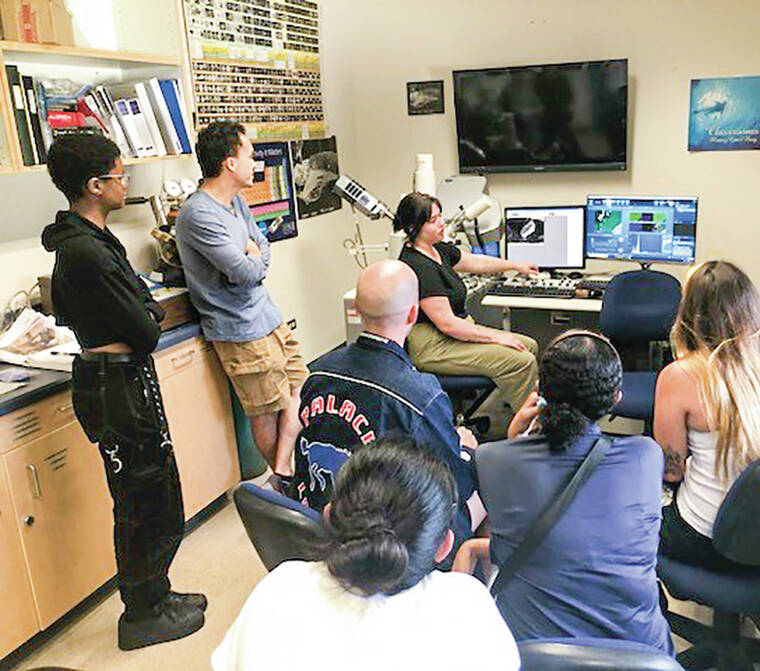Volcano Watch: Dear valentine, will you be my lab partner?
The USGS Hawaiian Volcano Observatory “lavas” working with our partners at the University of Hawai‘i at Hilo (UHH), and for Valentine’s Day we wanted to highlight some of the things we appreciate about this relationship.
Faculty and students in the UHH Geology and Anthropology Departments contribute to both volcano monitoring and research in Hawai‘i. Recently, seismic unrest southwest of Kilauea’s summit alerted HVO to a new intrusion of magma that occurred over a three-day period. The intrusion resulted in slight changes in ground elevations and new surface cracks along the Maunaiki trail in the Ka‘u Desert of Hawai‘i Volcanoes National Park.
ADVERTISING
UHH geology and anthropology faculty and students conducted GPS and leveling surveys over the past two weekends, tracking changes in the pre-existing cracks along the Koa‘e fault system south of Kilauea’s summit. The major cracks in this area (not to be confused with the new cracks) have been monitored since 1966 using much of the same equipment that we still employ today: a tape measure, a ruler 9.8 feet (leveling rod three meters) tall, and a telescopic sighting scope.
The data collected by the group shows that the faults along the Koa‘e were squeezed together by several inches (centimeters) and the ground was raised by more than a foot (30+ centimeters) in some areas from the intrusion. The surveying adds specific information to help “ground truth” other monitoring datasets in the area, such as satellite, GPS, and tilt.
HVO staff are also committed to giving back to the UHH community through education, outreach, and hands on student research and field opportunities. This week, HVO geologists participated in the UHH Geology department’s petrology laboratory course to expose students to analytical techniques. Petrology is the study of what rocks are made of.
During their regularly scheduled class period, HVO staff met with UHH students in the scanning electron microscope (SEM) laboratory housed in the Marine Science building.
For their lab assignment this week, student groups in the SEM lab learned techniques for doing petrological monitoring and research on Hawaii’s active volcanoes.
Students were shown how the SEM operates and how it can help scientists better understand the compositions of rocks and minerals from Hawaiian eruptions. Using a sample from Mauna Loa’s 1855-1856 eruption, we demonstrated how energy dispersive spectrometry (EDS) analysis can identify different types of minerals (olivine, plagioclase, pyroxene) based on the major elements in their chemical structure.
Students were also introduced to some new instrumentation on the SEM called a wavelength dispersive spectrometer (WDS). This new equipment, funded by the Additional Supplemental Appropriations for Disaster Relief Act of 2019 (H.R. 2157), allows us to conduct standardized measurements on samples that are quantitative and comparable to other analytical technologies. This type of functionality was not available on the Island of Hawai‘i prior to 2019.
In addition to education and outreach, HVO staff are committed to providing student opportunities for professional development and research. Through a cooperative agreement with the Research Corporation of the University of Hawai‘i, an undergraduate student works with HVO scientists in the lab, specifically focused on processing samples during eruptions for near-real-time geochemical monitoring.
In the fall of 2023, three additional students were involved in laboratory projects supporting ongoing research on Kilauea’s recent eruptions.
HVO has also hosted Pacific Internship Programs for Exploring Science (PIPES) students in the past, and, in the future, we hope to involve PIPES interns in laboratory-based research on Kilauea’s recent eruptions. Through these various activities HVO strives to support UHH students (and faculty), and this Valentine’s Day we wish to express our gratitude for all of their hard work.
Volcano activity updates
Kilauea is not erupting. Its USGS Volcano Alert level is ADVISORY.
Disbursed seismicity at Kilauea’s summit and along the Koa‘e fault system southwest of the caldera continues following an intrusion of magma into the area that occurred January 31-February 1, 2024; on average, earthquake counts remain below 10 per hour. Tiltmeters near Sand Hill and Uekahuna bluff have recorded little change over the past week, both show mild inflationary trends.
Periods of increased earthquake activity and rates of ground deformation can be expected to continue in this region.
No unusual activity has been noted along the rift zones.
Mauna Loa is not erupting. Its USGS Volcano Alert Level is at NORMAL.
Webcams show no signs of activity on Mauna Loa. Summit seismicity has remained at low levels over the past month.
Ground deformation indicates continuing slow inflation as magma replenishes the reservoir system following the 2022 eruption. SO2 emission rates are at background levels.
Nineteen earthquakes were reported felt in the Hawaiian Islands during the past week, those above M3 are listed here: a M3.4 earthquake 4 km (2 mi) WSW of Pahala at 36 km (22 mi) depth on Feb. 12, at 7:10 p.m. HST, a M3.8 earthquake 11 km (6 mi) E of Pahala at 0 km (0 mi) depth on Feb. 12 at 4:52 a.m. HST, a M3.4 earthquake 3 km (1 mi) WSW of Pahala at 36 km (22 mi) depth on Feb. 9 at 10:38 a.m. HST, a M3.5 earthquake 3 km (1 mi) SSW of Pahala at 34 km (21 mi) depth on Feb. 9 at 10:12 a.m. HST, a M3.0 earthquake 3 km (1 mi) WSW of Pahala at 37 km (22 mi) depth on Feb. 9 at 10:11 a.m. HST, a M5.7 earthquake 2 km (1 mi) SW of Pahala at 36 km (22 mi) depth on Feb. 9 at 10:06 a.m. HST, and a M3.1 earthquake 14 km (8 mi) ESE of Pahala at 0 km (0 mi) depth on Feb. 9 at 5:17 a.m. HST.
HVO continues to closely monitor Kilauea and Mauna Loa.


